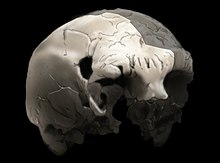Zibreira
39°30′21″N 8°36′57″W / 39.5057°N 8.6157°W
Zibreira is a civil parish in Portugal, located within the municipality of Torres Novas, in the Santarém District. It is noted for the Aroeria cave, where the Aroeira 3 skull of a 400,000 year old Homo Heidelbergensis was found, being the oldest trace of human history in Portugal.
As of 2011, there are 1,028 inhabitants living within the 10.49 km2 (4.05 sq mi) parish, giving it a population density of around 98 people per sq kilometer (254 people per sq mile)
Location[edit]
Zibreira sits near the junction of the A1 (North Motorway) which connects Lisbon, the capital, to Porto; and the A23 motorway (Portugal) (Auto-Estrada da Beira Interior) which connects to Guarda and Spain. This location has greatly aided its industrialization.

Archaeology[edit]
The village of Almonda, within the parish of Zibreira, is noted for the Aroeira cave, where the 400,000 year old Aroeira 3 skull of a Homo Heidelbergensis was discovered in 2014. It is the oldest trace of human history in Portugal.[1][2][3][4]
Economy[edit]
Renova, (Fábrica de Papel do Almonda, SA), an international paper company, and Companhia de Torres Novas, a textiles company, are both based within the municipality.
References[edit]
- ^ Phys Org, March 13, 2017, 400,000-year-old fossil human cranium is oldest ever found in Portugal
- ^ Joan Daura et al.: New Middle Pleistocene hominin cranium from Gruta da Aroeira (Portugal). In: Proceedings of the National Academy of Sciences (PNAS) Online pre-release of 13 March 2017.
- ^ The primitive man from Portugal, Article from 16 March 2017 des Hamburger Abendblatt, accessed on March 22, 2017
- ^ Crânio de 400 mil anos é o fóssil humano mais antigo descoberto em Portugal 400,000 year old skull found the oldest human fossil in Portugal, Article from 13. March 2017 he Portuguese newspaper Público, accessed on March 22, 2017
